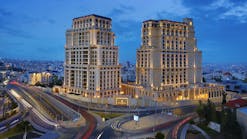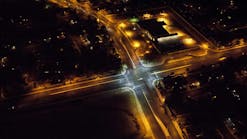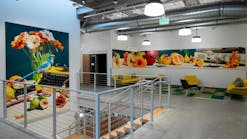The lighting program was conceived and managed by lighting artist Leni Schwendinger of Light Projects, Ltd., who identified LED fixtures located in doorways as the ideal way to achieve the desired light pattern. "We wanted to light the doorway and the sidewalk, with the light tapering off towards the curb," says Schwendinger. "When you look down the street, each doorway appears as a kind of illuminated welcome mat."
The Atlantic Avenue Local Development Corporation (LDC), who commissioned the lighting installation, is currently identifying additional funding sources to extend the installation over a two-year period to 150 doorways (or the entire length of Atlantic Avenue). The LDC is subsidizing the cost of the fixtures and the installation, so that property owners will benefit from a reduced electricity cost, possibly as much as 80% lower, incurred by running the LED-based lighting.
The desire on the part of the LDC for an energy-efficient lighting solution, and other factors, resulted in the selection of LEDs as the light source. "We looked at other light sources but all the others were too big and not well-shaped for the kind of small lighting fixture we wanted," says Schwendinger. "LEDs are miniaturized, and SYLVANIA had just produced a 1 W device and was very positive about being involved in the project."
The fixtures were engineered and manufactured by DesignPlan, and have a single optical cover, which was found to work better than individual lenses. "By working on the lens design, we were able to reduce glare from the fixtures," says Schwendinger. "You can look into the fixture and see the individual points of light, which is absolutely unexpected."
Furthermore, the optical system allows an even distribution of light. "The bulk of the illumination is deflected downward and outward from the building, which provides a lighting pattern to illuminate the areas occupied by pedestrians," he says.
O'Brien's company has experienced the effect of lighting on public attitudes and behaviors. "We noticed a very strong reaction, and increased public traffic to the Thomas Jefferson Memorial in Washington, DC after we completed the relighting of the memorial, and where the north-facing steps and the edifice were illuminated for the first time," said O'Brien. "This provided evidence that if you introduce lighting as one of the elements of the landscape you can influence human behavior."
Schwendinger thinks that the Atlantic Avenue pilot program can be replicated and sets a bold direction for bringing life to streetscapes throughout the U.S. "Just as LEDs are the future of lighting and energy efficiency, so new programs and approaches to lighting design are the future for cities," she says. "With this project, I hope we will inspire designers and urban planners to think in new ways about lighting, based on how the user and city visitor is affected by light."










